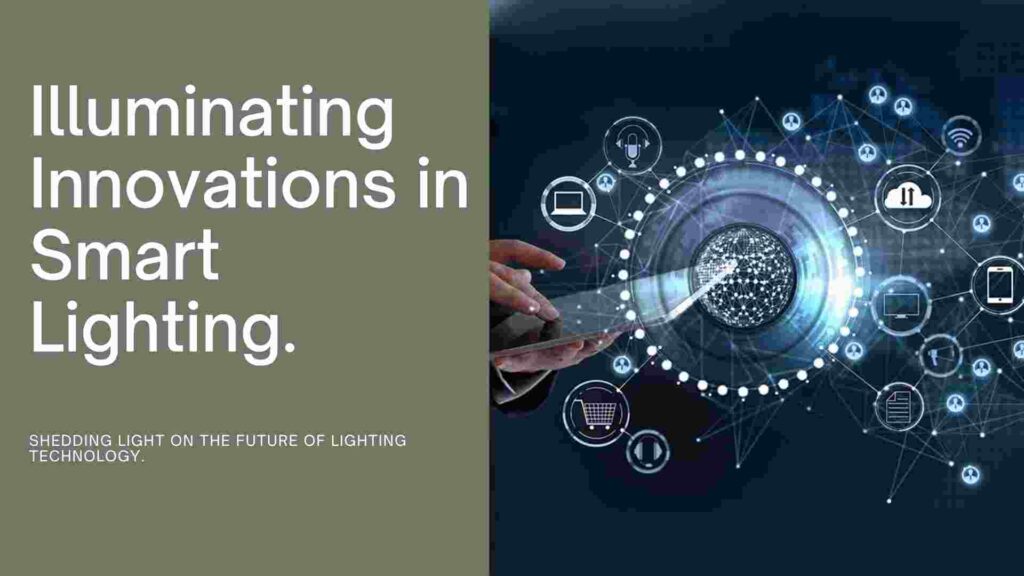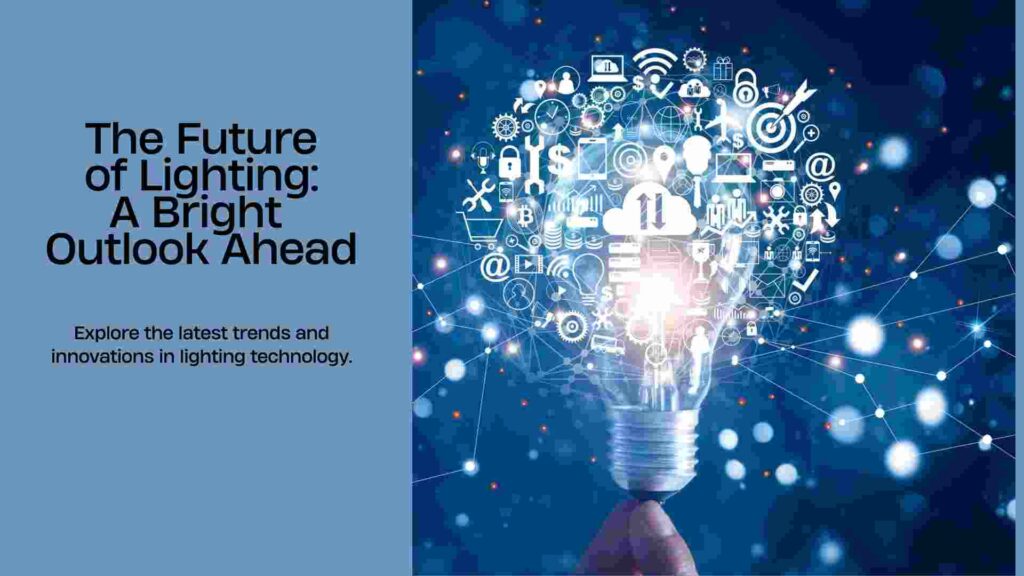The Future of Lighting is increasingly focused on achieving both energy efficiency and economic efficiency. Every industry is moving towards greater than, how we can describe, simply better, and lighting is not an exception. Modern lighting systems, as it is stated in this developed work, also capture the growing integration of ICT and the change in focus towards lighting products which are environmentally friendly. Clients can find themselves offered with smart LED light bulbs operated by the use of mobile phones or more complex systems of lighting able to respond to human activity and natural daylight.
One exciting development in lighting is the advent of intelligent lighting systems. These systems enhance convenience. They also contribute to significant energy savings. Smart bulbs can be programmed to turn off when not in use. This reduces unnecessary power consumption. Li-Fi technology uses light to transmit data. This innovation expands lighting capabilities, blending technology to enhance our spaces and industries. It boosts efficiency and productivity. Embrace these advances. Cutting-edge lighting will shape a sustainable future.
Technological Advancements in Lighting

Lighting technology has progressed significantly. Traditional lighting evolved into LED lighting. LEDs are more efficient and durable. Smart lighting systems are now popular. They allow control via smartphones. This offers better convenience and energy savings. Emerging technologies like Li-Fi and OLED are further enhancing lighting solutions, making them more innovative and efficient. These advancements are transforming lighting to be more adaptable and integrated into our daily lives.
Sustainability and Energy Efficiency
Energy-efficient lighting is crucial for reducing environmental impact. Sustainable lighting solutions, like LED and solar-powered lights, help lower energy consumption. They also cut carbon emissions. Governments promote ECO-friendly lighting with policies and incentives. This helps the planet and saves money.
- Sustainable lighting solutions, such as LED and solar-powered lights, help lower energy consumption and greenhouse gas emissions.
- Government Policies and Incentives, Governments are promoting green lighting through policies and incentives, encouraging both businesses and individuals to adopt ECO-friendly lighting options.
- Long-term Benefits, These efforts contribute to a healthier planet and cost savings over time.
Smart Lighting Systems

Explore the Benefits of Smart Home Lighting Systems.
Integration with IOT:
Intelligent lighting systems incorporate IoT for easy connectivity and management. They enable seamless control. This setup allows devices to interact, creating a unified and intelligent lighting atmosphere. Users can control their lighting remotely and create schedules that enhance energy efficiency and convenience.
Lighting Systems with Automation and Control Features :
These systems have got automation as well as control wherein people can change their lighting from their phones or via voice commands thus easing energy saving mechanisms further. Other developments include the use of light switches that have motion sensor technology that reacts when people enter or leave a room and turns the lights off or on depending on the number of occupants in a room as well as the light level GPON. Other than saving energy time, comfort for the users of these features is greatly increased.
Impact on Residential Sectors :
In residences, smart lighting enhances comfort and helps reduce energy costs by naturally adapting to how people would carry out their daily activities and the availability of light during the day. It is also possible to program scenes and time schedules for different times of the day when various activities are likely to be performed around the house hence the ideal mood created. Integration of smart home movers and shakers that include alexa and google home with lighting systems makes it easy to operate lighting using the voice command.
Impact on Commercial Sectors :
In offices and businesses, smart lighting enhances productivity and can significantly cut operational costs by optimizing light usage. Automated lighting systems can adjust based on the presence of employees, ensuring that lights are only used when needed. Smart lighting saves energy and extends fixture lifespan. It improves employee well-being by reducing eye strain and boosting concentration.
Training and Education :
To enhance the advantages that can be obtained from utilizing modern lighting technologies, training and education on the use of such systems extends to lighting professionals, installers, as well as end-users. Such training programs and educative sources enhance better initiatives by the professionals concerning making sound decisions. They add to perfection of system management and resolution of problems.
Impact on Industrial Sectors :
In industrial settings, intelligent lighting systems enhance safety and efficiency. They ensure optimal lighting for different environments, like factories and warehouses. Lighting adjusts to specific area needs: bright for workstations, dim for storage. Customization improves visibility and safety for workers. It also cuts energy costs in industrial settings.
Innovations and Future Trends

- Sensory Adaptive Lighting controls the intensity and color of light based on the surrounding and the end user. Therefore, these systems maximize power usage and the comfort of the users in any situation.
- AI and Machine Learning in the industry Lots of lighting systems have come to appreciate the role of artificial intelligence and machine learning systems in their operation. These innovations offer smart lighting systems maximum flexibility by learning how their users operate.
- Lighting Inspired by Nature Learning from nature’s design principles and applying them in solving lighting problems in various environments is gaining popularity. Such natural lighting devices, like the trees filtering sunlight, offer good design and relaxes people.
- Sustainability and Circular Economy Circular Economy and the greening of lighting systems will be one of the key features of lighting in future. New designs of lighting products have come up that are eco-friendly, energy-efficient, durable and recyclable to reduce environmental impacts over their lifespan.
- Connectivity and Interoperability Tendencies towards further interconnection and integration of lighting systems with other smart devices only strengthens. Such ecosystems that are connected to smart home platforms allow for more efficient and effective management and automated action.
- Enhanced User Experience Enhancement of the user experience will definitely be key for future trends in lighting design and technology by appealing. This is to ensure that design processes are user centered and therefore improve control over lighting systems in ways that matter.
Case Studies and Real-World Applications

Development of Smart Cities and Public Lighting Programs Global smart city initiatives are exploring new public lighting programs in order to reach energy efficiency, increase security and enhance the liveability of cities. Such projects often involve installing Light Emitting Diode (LED) street luminaires equipped with sensors to collect data on the surroundings, traffic and pedestrians.
Enhance Buildings with Smart Lighting Design
Redesign OTT Solutions and Customer Processes. Such lighting solutions are employed into the works of architects and designers in order to improve the appearance and the use of the building. For example, the lights are equipped with illuminates that change according to the activity of the user or the conditions in the surrounding area. Lighting designs combine with building structures materials to create beautiful Effects.
Industry Success Stories with Modern Lighting Technologies
Success Stories from Various Industries Different industries are to an extent embracing the modern lighting technologies. Supermarkets utilize intelligent lighting to enhance the shopping experience for their customers and increase sales while health care facilities apply human centric lighting for successful health outcomes. Likewise, such places as the hospitality sector use new ways of lighting to enhance their guests’ experience and stand apart from competitors.
Boosting Efficiency and Productivity with Lighting Upgrades
Impact of Lighting Upgrades Case studies of lighting upgrades across various fields such as commercial and industrial focuses indicates a huge benefit to the energy efficiency, productivity and general satisfaction. Substituting the old conventional lighting with efficient LED lighting combined with addition of automated lighting controls can assist in lowering the operational cost, raise employee morale, and raise the quality of products or services offered by the business.
Key Lessons and Best Practices for Lighting Technology Use
Lessons Learned and Best Practices Field based uses of lighting technologies have a few lessons learnt and such practice tips which will be beneficial for later endeavors. Such practices enable all the interested parties to foresee the lighting upgrade, installation and maintenance which will optimize the performance in the long term return on such investment.
Also Read More : Impact of LED Lights on Plant Growth and Development
Challenges and Considerations
Technological Challenges and Solutions Despite advancements, the lighting industry encounters technological challenges like compatibility, cyber security, and interoperability issues. However, ongoing research and development efforts aim to address these challenges through improved standards, protocols, and security measures.
Cost Implications and ROI Cost considerations play a significant role in the adoption of advanced lighting technologies. Initial costs are higher, but energy-efficient lighting brings long-term savings.
Security and Privacy Concerns
The integration of smart lighting systems with IOT devices raises security and privacy concerns. Weaknesses in network infrastructure and data breaches require strong encryption and authentication. Privacy policies are crucial too. Furthermore, educating users protects sensitive information.
Environmental Impact
Energy-efficient lighting technologies offer environmental benefits, the manufacturing and disposal of lighting products can have environmental impacts. Sustainable practices, such as using recycled materials, minimizing packaging waste, and promoting product recycle ability, are crucial for mitigating these effects and promoting a circular economy.
Regulatory Compliance
Compliance with regulatory requirements and industry standards is essential for ensuring the safety, performance, and legality of lighting products. Manufacturers must adhere to regulations related to energy efficiency, product labeling, hazardous substances, and electromagnetic compatibility to market their products globally.
Conclusion
In conclusion, the future of illumination is promising. It’s driven by technology, sustainability, and well-being. The industry integrates biophilic design for efficient and user-friendly solutions. Looking ahead, lighting goes beyond illumination, affecting productivity, healthcare outcomes, and ambiance. IOT and AI transform lighting interaction, enhancing intuitiveness and responsiveness.
However, along with the opportunities, there are challenges to overcome. From technological hurdles to environmental concerns and regulatory compliance, stakeholders must navigate a complex landscape to realize the full potential of modern lighting technologies. Yet, with concerted efforts and collaboration, these challenges can be addressed, paving the way for a brighter, more sustainable future.
In essence, embracing the future of lighting is not just about upgrading fixtures and bulbs; it’s about creating environments that enhance comfort, productivity, and well-being while minimizing environmental impact. By leveraging innovation, education, and best practices, we can illuminate the path towards a smarter, greener, and more illuminated tomorrow.

